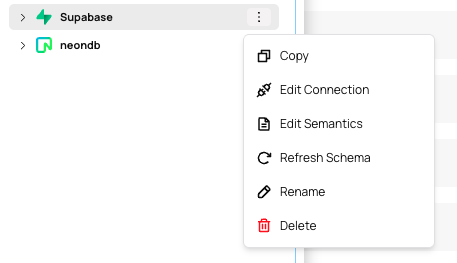Overview
Fabi.ai leverages AI context and semantics to enhance its understanding of your data sources. By providing additional context in plain text or markdown, you can guide the AI to interpret your data more accurately, generate more relevant insights, and streamline your data analysis workflows. These settings are applied globally for all users accessing a specific data source.Providing AI context
To access a data source’s context, click on the overflow menu next to any source and click Edit Semantics
Plain text context
You can provide general context about your data source in plain text. This is useful for describing the overall purpose, key metrics, or any specific nuances of the data that the AI should be aware of. Examples of plain text context:- “This database contains sales data from our e-commerce platform, including customer information, product details, and order history. The primary key for the ‘orders’ table is ‘order_id’.”
- “The ‘transactions’ table stores all financial transactions. The ‘amount’ column is in USD, and ‘transaction_date’ is in UTC.”
Markdown context
For more structured and detailed context, you can use markdown. This allows you to include formatting, headings, lists, and code blocks to provide comprehensive guidance to the AI. Markdown is ideal for explaining complex relationships, business logic, or specific data definitions. Examples of markdown context:Global application
All AI context and semantic settings you configure for a data source are applied globally. This means that any user within your Fabi.ai workspace who accesses that data source will benefit from the enhanced AI understanding, ensuring consistent and accurate analysis across your team.Best practices
- Be specific: The more detailed and specific your context, the better the AI can understand and interpret your data.
- Keep it updated: As your data sources evolve, update the AI context to maintain accuracy.
- Focus on business logic: Provide context that explains the business meaning of your data, not just technical details.